
Station Name: HOLMFIRTH[Source: Alan Young]
Holmfirth Station Gallery 2: August 1953 - 6 September 1964
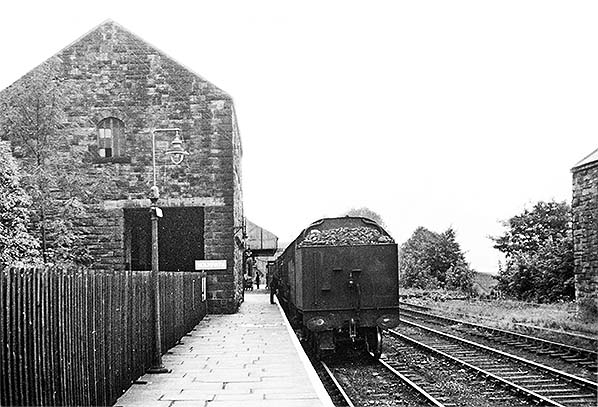 Looking south-west along the single platform of Holmfirth, the branch terminus, in August 1953. The 5.05pm train is seen with its loco working bunker-first. The large building is the woollen ‘tranship’ warehouse. Beyond it the large verandah can be seen. The gas lighting is of ‘Sugg’ type dating from the later LMS or BR period. A small LMS nameplate is fixed to the standard. The placing of a nameboard, which does not face the track, is somewhat unconventional. The loco, No.42409, is Fowler-designed Class 4P-D, built in October 1933 at the LMS Derby works and which carried the LMS number 2409. She was withdrawn from 20A, Leeds Holbeck shed, in January 1964 and cut up at BR(NE) Darlington Works North Road the following month. Copyright photo by HC Casserly 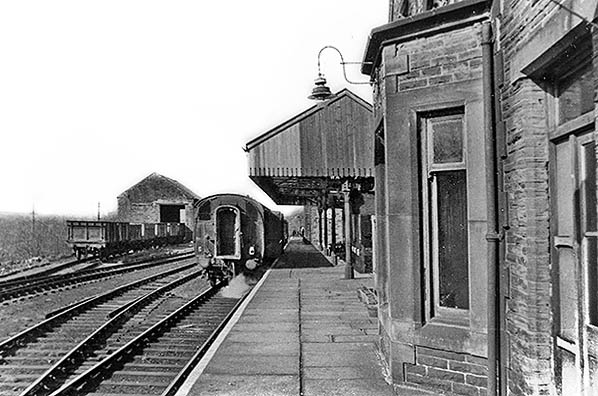 Looking north-east at Holmfirth station in May 1955. The bay window of the station building is in the foreground and, beyond it, the large verandah installed in the 1890s. The goods sidings with a rake of wagons and the goods warehouse can be seen to the left.
Copyright photo from Stations UK  Looking north-east at Holmfirth station in September 1955. The handsome Tudoresque station building, dating from the station’s opening in 1850, stands to the right. The array of water / sand buckets will be noted, hanging from hooks on the wall. Beyond the station building is the generously-sized verandah installed in the 1890s, with the two-storey woollen ‘tranship’ shed at its far end. The goods facilities, including the stone-built warehouse, are on the left. A branch train stands at the single platform.
Photo
from John Mann collection
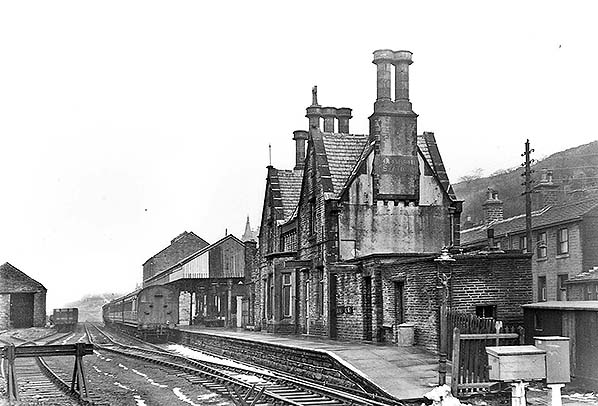 In the early 1950s a three-coach branch passenger train is standing at Holmfirth station. The Tudor Gothic station building and the platform verandah are clearly shown in the north-eastward view. The woollen ‘tranship’ shed beyond the verandah can be seen; this was demolished by autumn 1956. The goods warehouse and its sidings are to the left.
Photo from John Mann collection  Looking north in November 1956 along Station Road, Holmfirth, at the Tudor Gothic station building.
Photo by J C W Halliday 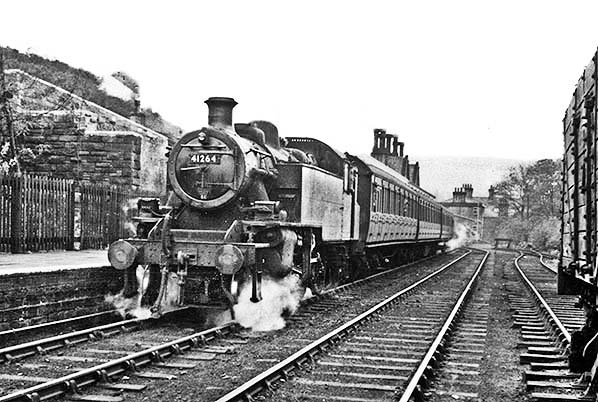 Holmfirth station looking south on Saturday 3 November 1956. The three-coach train is most likely the 1.33pm departure, and it is headed by Ivatt-designed Class 2MT-A 2-6-2T No.41264. The loco was built at BR Crewe works in July 1950. She was withdrawn in December 1966 from 12A, Carlisle Upperby shed, and cut up by Campbells, Airdrie, in January 1968.
Photo by J C W Halliday 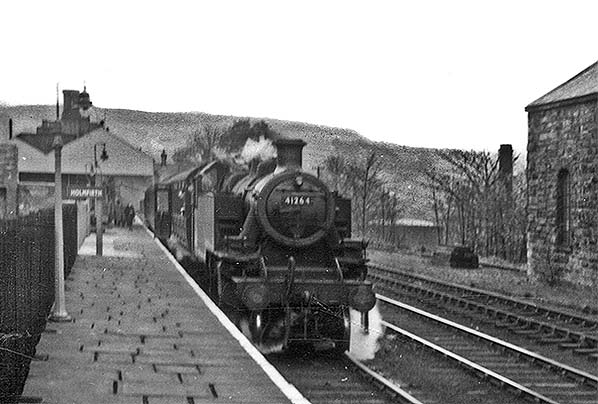 Holmfirth station looking south-west on Saturday 3 November 1956. Another view of what is most likely the 1.33pm departure for Huddersfield.
Photo by J C W Halliday  Holmfirth station looking south-west on Saturday 15 February 1958. The train is most likely the 1.33pm Saturday-only service to Huddersfield. The unconventionally-placed nameboard projects from the remains of the woollen ‘tranship’ shed, and replacing the gas lamps that formerly hung from the shed are two lamps on modern standards. The loco is Ivatt-designed Class 2MT-A 2-6-2T, No.41250, built in November 1949 at BR Crewe works. She was withdrawn on 30 November 1963 from 37B, Leeds Copley Hill shed, having been stored at Ardsley shed since July of that year. The loco remained at Ardsley until taken in February 1964 to BR(NE) Darlington Works, North Road, where she was cut up
the following month Photo frolm John Mann collection 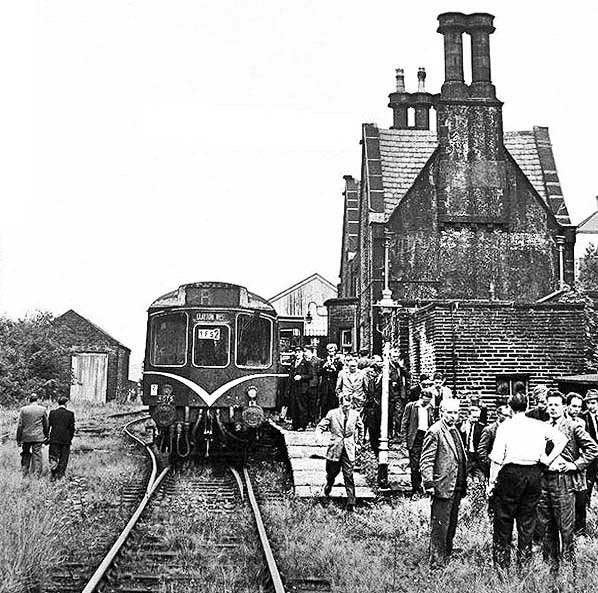 On 6 September 1964 the RCTS ‘West Riding Rail Tour’ is visiting Holmfirth. The station had closed to passengers in 1959 but would remain open for goods until 1965. The buildings remain in good order, though the railway tracks would benefit from the visit of a weedkiller train. As is expected in rail tours of this time, the perhaps exclusively male passengers seen here are smartly attired, and some are straying beyond the platform and onto the trackbed. This rail tour had an ambitious itinerary which also included a remaining part of the Queensbury lines, the Meltham and Kirkburton branches – all closed to passengers – and the Clayton West branch. The DMU seen here is a 3-car BRCW set; it is coupled to a 2-car Metro Cammell set.
Photo from Jim Lake collection 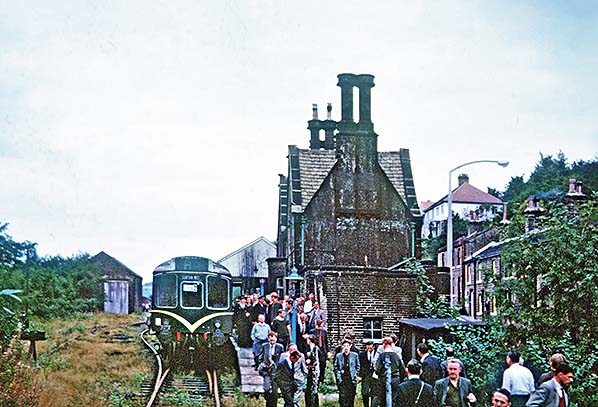 On 6 September 1964 the RCTS ‘West Riding Rail Tour’ is visiting Holmfirth. The station had closed to passengers in 1959 but would remain open for goods until 1965. The Tudor Gothic station building, black with soot, is accompanied by the platform verandah beyond it. The gas lamp standard at the platform ramp and the verandah pillars have been painted in ‘Oriental Blue’ by BR(NE), the region that had operated the branch from 1950.
Photo from Martin Bairstow collection  Looking south at Holmfirth station from the goods tracks. On 6 September 1964 the RCTS ‘West Riding Rail Tour is visiting Holmfirth as part of an ambitious itinerary which also included a remaining part of the Queensbury lines, the Laisterdyke to Batley line which had lost its passenger service the previous day, the Meltham and Kirkburton branches – all closed to passengers – and the Clayton West branch. The chimneystacks of the main building and the platform verandah are visible above the train, and the goods warehouse is left of the rails. In rail tours of this time passengers were permitted to wander across the rails without let or hindrance, as they are doing here.
Photo
from Martin Bairstow collection
Click here for Holmfirth Station Gallery 3:
|
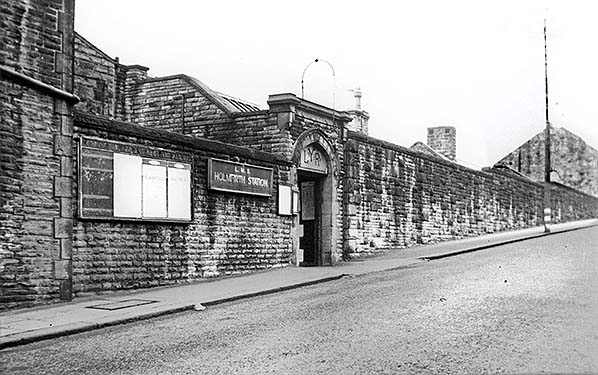
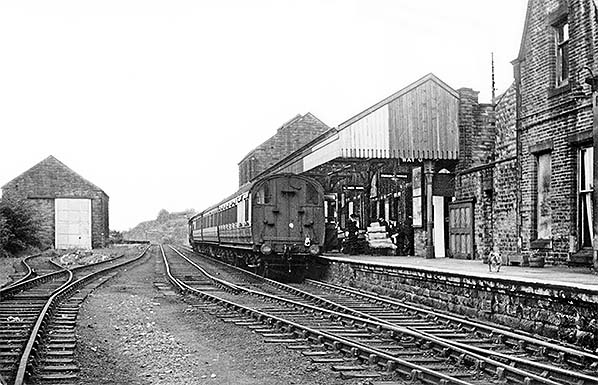 Looking north-east at Holmfirth station in August 1953. A branch push-and-pull train stands at the single platform to form the 5.05pm departure. Far right is part of the station building (1850) and beyond is the verandah built in the 1890s; at the far end is the two-storey woollen ‘tranship’ shed. The goods sidings on the left are conspicuously quiet. The single-road goods warehouse is to the left.
Looking north-east at Holmfirth station in August 1953. A branch push-and-pull train stands at the single platform to form the 5.05pm departure. Far right is part of the station building (1850) and beyond is the verandah built in the 1890s; at the far end is the two-storey woollen ‘tranship’ shed. The goods sidings on the left are conspicuously quiet. The single-road goods warehouse is to the left.
 Home Page
Home Page